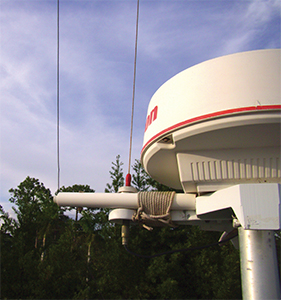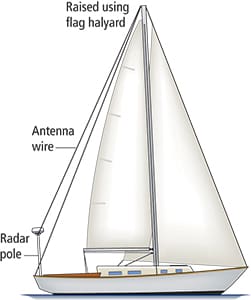A couple of years ago, good friends from Islesboro, Maine, lost their rig overboard on their 40-foot sailboat off St. John’s, Newfoundland. Apparently the backstay fitting at the top of the mast failed. Kathy and I immediately thought of our own aging backstay on our 34.5-foot Tartan sloop. We decided to replace it during the upcoming fall term at our Florida yard.
Our existing backstay was 1/4-inch-diameter 1×19 stainless steel wire with four swage fittings. As many owners have done, we used a portion of the backstay as an HF SSB antenna. Years ago, we cut the backstay and installed two insulated swage fittings 27 feet apart. In addition, we have about 6 feet of antenna feed wire from the antenna to the tuner, making the total random wire antenna about 33 feet long. Thirty-three feet is one quarter wavelength of the 40-meter (7.0+ MHz) ham frequency. As a result, our old backstay had four swage fittings: one at the top, one at the bottom and two insulated fittings 27 feet apart.
Once we took the mast out of the boat, we had to make several decisions. While no one really knew what happened to our friends’ rig off St. John’s, we surmised the swage fitting at the top of their mast failed. Meanwhile, we experimented and discovered that our SSB automatic antenna tuner would tune up nearly any length of wire. By tune up, I mean see a very low standing wave ratio (SWR) on the ham/SSB radio. Some sailors are convinced the new automatic antenna tuners can tune up a beer can!
This meant we could forget insulator fittings in the new backstay and not be overly concerned with cutting the backstay to a specific frequency-dependent length. We’d love to use the entire new backstay as an antenna but it’s grounded at top and bottom. We still need an antenna for the SSB and there are lots of ham/SSB aficionados out there with many sailboat antenna designs. Rather than get into an endless antenna design discussion, we used one of our signal halyards at the top of the mast and hauled up an antenna wire connected to our tuner in the aft lazarette.
 |
|
The wire is led up the radar pole and then outboard on an extension arm. |
I created a new backstay with the mast on sawhorses. First we used the toggle-to-toggle length of the old backstay with the swage fitting in place as a guide to cut the new wire, taking into account the different length of the new compression fittings. Cutting the new backstay to an exact length is not a problem since our adjustable backstay turnbuckle arrangement back aft can adjust a couple of inches. I increased the size from 1/4-inch to 9/32-inch 1×19 stainless steel rigging wire because it was easy to do and made me feel better. I’m certain the breaking strength of 1/4-inch wire is plenty adequate. No more swage fittings. The top and bottom 9/32-inch compression fittings were about $60 each and can be installed with the mast out by experienced sailors without special tools.
Another option that avoids having to cut the backstay is to use a GAM/McKim Split Lead Antenna from GAM Electronics. This is a unit that press fits on the backstay wire.
The cost of the new separate signal halyard wire antenna was less than $20. The total cost of the new backstay was about $400, including the signal halyard antenna. I separated the SSB antenna from the grounded backstay by leading the antenna wire through an extension on our radar post. Both the ham and SSB channels tune up great (low SWR) and I frequently check into the cruiser nets.
Dick de Grasse and his wife Kathy live aboard their Tartan 34, Endeavour, in Florida during the winter and in Islesboro, Maine, during the summer.

